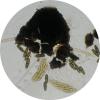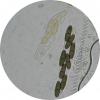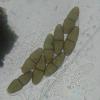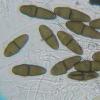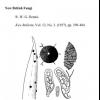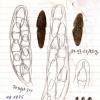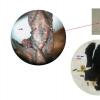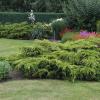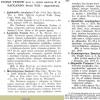
21-12-2025 21:32
Pol DebaenstHello, Garden, Burgweg 19, Veurne, BelgiumOn 10/1

21-12-2025 21:40
Isabelle CharissouBonjour, j'aimerais connaitre les références de

21-12-2025 21:31
Pol DebaenstHello, Garden, Burgweg 19, Veurne, BelgiumOn 10/1

21-12-2025 21:31
Pol DebaenstHello, Garden, Burgweg 19, Veurne, BelgiumOn 10/1

20-12-2025 23:08
Patrice TANCHAUDBonsoir, récolte sur sol sablonneux dans l'arri�

21-12-2025 09:32
Hello.A tiny ascomycete found embedded in wood in

20-12-2025 15:47
Mirek GrycHi.These grew on pine wood that was heavily covere

Bonjour,
Est-ce que cela pouvait être Seynesiella juniperi?
Substrat: Juniperus sp.
Ascomata: large 150-200 µm, hauteur 125-200 µm.
Asci: 90 - 140 x 22 - 30 µm
Spores: 23-28(30) x 7-9 µm
Aucune gouttelette observé
Merci de votre aide
Piet Bormans
Beaucoup d'éléments plaident en faveur de S. juniperi mais tes spores sont légèrement trop grosses pour cette espèce, et en général elles sont moins brunes et une cellule est généralement plus petite que l'autre.
Tes ascomatas sont bien hémisphériques, tu confirmes ?
Ceci étant, je ne vois pas ce que cela pourrait être autre que cela.
Alain
;)
http://www.springerimages.com/Images/RSS/1-10.1007_s13225-011-0143-8-8
Alain

;)
bien sûr . . . .

Un grand merci à Chris, Alain et Zotto. Aussi à Ascofrance qui nous offre cette possibilité
Piet Bormans

Zotto

Piet
Just to add to the confusion. Perhaps the Scottish collection to which Dennis refers is in fact a Stomiopeltis species. He mentions this in his book on British Ascomycetes. I also notice that Stomiopeltis juniperi is described in Ellis & Ellis (Microfungi on Land Plants. I'm inclined to go with Seynesiella for your collection.
You probably have noticed these references but I thought it might be useful, nevertheless.
By the way, I have not seen this species in PEI but I will keep an eye out.
Sincerely,
Adrian Carter

about your fungus on Juniperus again: I did not get a clear picture about the ascomata. Are they longish/columnar? Is the ascus-bearing part in the end, on a stipe? In that case it may be Pododimeria gallica, although in that species ascospores are even more asymmetric and up to 11 µm wide.
On the other hand, one of your images shows parallel rows of cells in the upper peridium, which is in line with thyriothecia-forming fungi. So, Seynesiella is in principle possible.
About Seynesiella juniperi: Wu et al. (Fungal Diversity 51) examined and illustrated a syntype of Desmazieres, i.e. it is original. It shows smaller, lighter and asymmetric ascospores, which is line with Dennis. I am not sure whether they saw the entire range of ascospores. It may be that the material was not quite mature, and that they missed larger and darker brown spores (??).
Müller & Arx give a kind of intermediate spore size of 20-25 x 7-9 µm (probably adapted from Saccardo in Sylloge Fungorum II: 664 (1883)-not Fungi Veneti, who should have copied it from Desmazieres. Unfortunately I do not have Desmazieres´paper. Arnaud (1918), who established Seynesiella, did not mention a spore size. Saccardo also called the spores hyaline to very dilute chlorine.
By the way, Stomiopeltis has small hyaline spores.
Best regards,
Walter Jakllitsch
?
The Desmazières's description is online. Look at URL:
http://bibdigital.rjb.csic.es/spa/Libro.php?Libro=2204&Pagina=141
Best, Guy

Piet Bormans


